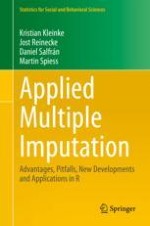2020 | OriginalPaper | Buchkapitel
3. Missing Data Methods
verfasst von : Kristian Kleinke, Jost Reinecke, Daniel Salfrán, Martin Spiess
Erschienen in: Applied Multiple Imputation
Aktivieren Sie unsere intelligente Suche, um passende Fachinhalte oder Patente zu finden.
Wählen Sie Textabschnitte aus um mit Künstlicher Intelligenz passenden Patente zu finden. powered by
Markieren Sie Textabschnitte, um KI-gestützt weitere passende Inhalte zu finden. powered by
